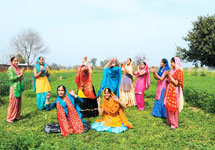About Punjab
 Punjab is an Indo-Iranian word meaning "the land of five rivers". Punjab lies at the cross-roads of the great civilizations of the world. Historicaly, the area west of Punjab was under the sphere of influence of the Persians, the east was the heartland of the Indian civilization, the south under the influence of the Arabs and the north under the Turko-Mongolian influence. Many great religious movements which found world-wide appeal grew in the fertile plains of Punjab. They include Budhism, Sikhism and many schools of Sufi thought in Islam. This ethnic and religious diversity is reflected in the cultural mosaic of today’s Punjab.
Punjab is an Indo-Iranian word meaning "the land of five rivers". Punjab lies at the cross-roads of the great civilizations of the world. Historicaly, the area west of Punjab was under the sphere of influence of the Persians, the east was the heartland of the Indian civilization, the south under the influence of the Arabs and the north under the Turko-Mongolian influence. Many great religious movements which found world-wide appeal grew in the fertile plains of Punjab. They include Budhism, Sikhism and many schools of Sufi thought in Islam. This ethnic and religious diversity is reflected in the cultural mosaic of today’s Punjab.
The historical area of Punjab was defined to the east from the basin of the river Bias (including Dehli) to the basin of River Indus in the west. To the north it was bounded by the Himalayas of Kashmir and to the south it stretched as far as the plains of Cholistan and Rajasthan. Over different periods of history Punjab has seen its boundaries expand and shrink. The high time for Punjab was during the reign of Mughal emperor Babur (and also during the time of Ranjit Singh more recently) when Punjab along with Babur's empire stretched from Dehli in the east to Kabul and Ghazni to the West. But never in the history, did the boundaries of Punjab shrink so much as they did after the division of India in 1947. The tragic incident resulted in the division of Punjab into two parts as the Indian state of Punjab and the Pakistani province of Punjab. Indian Punjab was further divided twice for administrative reasons. Today's Punjab (Indian) is about one-fourth of the Punjab that existed before partition.
Punjab suffered the most destruction and damage at the time of Partition of India. Prior to partition the Punjab extended across both sides of what is now the India-Pakistan border and its capital Lahore is now the capital of the Pakistani state of Punjab. The major city in the Punjab is Amritsar, the holy city of the Sikhs. Chandigarh, a new planned city, was conceived and built in the 1950s to serve as the capital of the new Punjab. In 1966, Punjab underwent another split. It was divided into the predominantly Sikh and Punjabi- speaking state of Punjab and the state of Haryana. At the same time some of the northern parts of the Punjab were hived off to Himachal Pradesh. Chandigarh on the border of Punjab and Haryana, remains the capital of the two states, yet is administered as a Union Territory from Delhi.
The Punjab's per capita income is nearly double the all-India average (in second place is Haryana). Although Punjabi's comprise less than 2.5% of India's population, they provide 22% of India's Wheat and 10% of its rice. The Punjab provides a third of all the milk production in India. Punjab also has a number of thriving industries including Hero Bicycles at Ludhiana.
From the traveller’s point of view, the area has just one attraction -the beautiful Golden Temple in Amritsar. Apart from this the states are mainly places of transit for travellers on their way to the Himachal hill stations, Pakistan, and Kashmir.
Main Links
Travel Information
Exploring Punjab - Vacations
Punjab's Forestry and Wildlife
The Unique eco-system of the Shivaliks is spread over a geographical area 9448.97 Sq. km, and lies in the north-eatern part of the state extending from north-west to south-east along the Himachal Pradesh Border. It is spread across the eastern part of the districts of Gurdaspur, Hoshiarpur, Shaheed Bhagat Singh Nagar and Rupnagar


